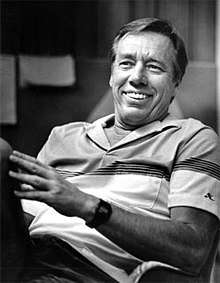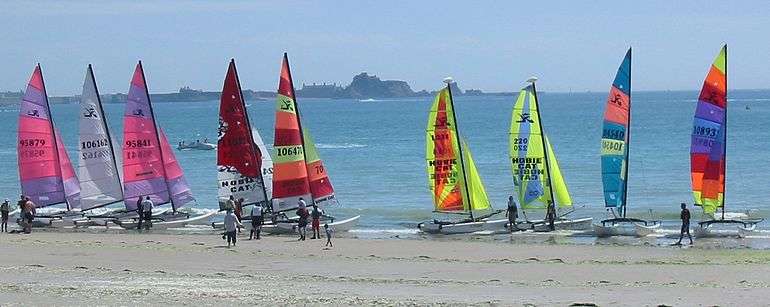Hobart Alter
Hobart "Hobie" Alter (October 31, 1933 – March 29, 2014) was an American surf and sailing entrepreneur and pioneer, creator of the Hobie Cat catamarans, and founder of the Hobie company.
Hobart Alter | |
|---|---|
 | |
| Born | Hobart Laidlaw Alter October 31, 1933 Ontario, California, U.S. |
| Died | March 29, 2014 (aged 80) Palm Desert, California, U.S. |
| Occupation | Sports equipment fabricator |
| Children | Three |
Biography
Hobie Alter will be remembered for creating the process of the foam-and-fiberglass surfboard & his subsequent creation of the Hobie Cat catamaran sailing boat line. His label, Hobie, remains one of the top-selling surfboard brands of all time. He is also the creator of the Hobie 33 ultralight-displacement sailboat and a mass-produced radio-controlled glider, the Hobie Hawk.[1]
During summer vacation 1950 "Hobie" hit on an idea . ""Hobie began by building 9-foot balsawood sufboards for his friends. He asked his dad to pull the Desoto out of the family's Laguna Beach, California garage, and converted it into a wood shop for his hobby.[2]
Hobie's hobby became a business and in discussing the future with friends as a young man "Hobie" declared that he wanted to make a living without having to wear hard-soled shoes or work east of California's Pacific Coast Highway. By “Making people a toy and giving them a game to play with it”. A couple of years later, Hobie opened up Southern California's first surf shop in Dana Point, California.
1958 Hobie and Gordon "Grubby" Clark began experiments making surfboards out of foam and fiberglass. The new boards were lighter, faster and more responsive than wooden ones. Several famous surfers surfed for the Hobie Team, including Joey Cabell, Phil Edwards, Corky Carroll, Gary Propper, Mickey Munoz, Joyce Hoffman and Yancy Spencer.
Alter was inducted into the National Sailing Hall of Fame in 2011.[3]
Youth
Hobie was born and raised in Ontario, California, but his family had a summer house in Laguna Beach, where Alter got into the full array of ocean sports. Initiated into surfing by Walter Hoffman, he started shaping balsa boards in the early 1950s. When the family's front yard became cluttered with the remnants of surfboard production, his father moved him off the property by buying him a lot on Pacific Coast Highway in nearby Dana Point for $1,500. That was 1953. In February 1954, with the first stage of the shop completed, Hobie Surfboards opened its doors after a total investment of $12,000. "People laughed at me for setting up a surf shop," Hobie remembers. "They said that once I'd sold a surfboard to each of the 250 surfers on the coast, I'd be out of business. But the orders just kept coming."[1]
Alter began making skateboards in 1962 and by 1964 he teamed up with the Vita Pakt juice company to create Hobie Skateboards. Alter went on to sponsor the Hobie Super Surfer skateboard team.[4][5][6]
Alter hired other board-builders, including Phil Edwards and Reynolds Yater. With the introduction of foam-and-fiberglass technology, Alter brought Joe Quigg over from Hawaii to help keep up with demand. Then came the high-volume production shapers like Ralph Parker and Terry Martin, guys who have shaped hundreds of thousands of surfboards over the years. Other Hobie shapers included Dewey Weber, Mickey Munoz, Corky Carroll, Don Hansen. Bruce Jones and the Patterson brothers.[1]
After experimenting with foam for a couple of years, Hobie made a breakthrough in 1958, finally achieving the right skin hardness for shapeability with the right core density for strength. He decided to set up a separate foam-blowing operation in nearby Laguna Canyon and recruited one of his glassers, Gordon "Grubby" Clark, to make polyurethane surfboard blanks. Almost immediately, Gidget was released, and surfing (and the demand for surfboards) boomed. "If that movie had come out in the balsa era," said Alter, "no one could have supplied them."[1]
The new foam boards were called Speedo Sponges and Flexi-Fliers, and Hobie was soon manufacturing 250 a week. Clark eventually took over the foam operation, renaming it Clark Foam, and he serviced the lion's share of the world's surfboard blank market until abruptly shutting down the company in 2005.[1][7]
Alter was a surfing competitor in his younger days. He won the second Brooks Street contest in Laguna in 1954 and placed third and fourth at the Makaha International Surfing Championships in 1958 and 1959. He achieved success as a tandem surfer, placing second in the event at Makaha in 1962. Alter made the Guinness Book of World Records in 1964, surfing the wake of a motorboat 26 miles from Long Beach to Catalina Island.[1]
Hobie Cat

Alter's Hobie Cat became the nucleus of a very successful worldwide catamaran business.
The company created 16 unique sail boats from the Hobie 10, once designed to compete with the Laser, to the Hobie 33, a 33-foot (10 m) monohull. lift-keel boat.
Alter sold Hobie Cat to the Coleman Company, Inc. in 1976, and his sons Hobie Jr. and Jeff carry on the family tradition, operating Hobie Designs and overseeing the company's licensing operations. Before his death, Alter would divide his time between the mountains of Idaho (where he skied in the winter) and Orcas Island, the largest of the San Juan Islands in the Pacific Northwest, where he would anchor his 60-foot, foam-core, twin-Diesel power catamaran, that he designed and built for himself.[1]
Death
Alter died of cancer in Palm Desert, California on March 29, 2014 at the age of 80.[8]
References
- Kampion, Drew. "Surfing A-Z" (Website). Surfline. Retrieved 7/10/2007. Check date values in:
|accessdate=(help) - "Company History". Hobie Website. Archived from the original (Company Website) on 2007-10-06. Retrieved 7/10/2007. Check date values in:
|accessdate=(help) - "Alter, Hobie 2011 Inductee". Nshof.org. Retrieved April 11, 2020.
- The Surfboard Collectors. "Hobie Surfboards". Retrieved November 2, 2012.
- Michael Brooke (1999). "The Concrete Wave: The History of Skateboarding". Warwick Publishing Inc. Retrieved November 2, 2012.
- Ben Marcus (2011). "The Skateboard: The Good, the Rad, and the Gnarly: An Illustrated History". MVP Books. Retrieved November 2, 2012.
- William Finnegan (August 21, 2006). "Blank Monday". The New Yorker. Retrieved March 31, 2014.
- Anton, Mike (30 March 2014). "Hobie Alter dies at 80; shaped Southern California surf culture". Los Angeles Times.
External links
- www.hobie.com Hobie company site